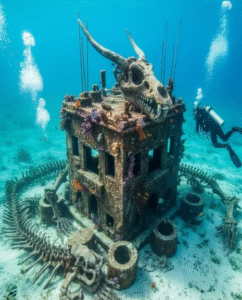Ancient Canaanite Merchant Vessel: A Deep-Sea Revelation
The sea has long guarded its secrets — silent, patient, and impenetrable. For millennia, the deep waters of the Mediterranean have hidden traces of civilizations that shaped humanity’s earliest trade networks. But now, a breathtaking new discovery has pierced that watery veil: an ancient Canaanite merchant vessel, astonishingly preserved, resting quietly at the bottom of the sea.
This revelation is rewriting what historians thought they knew about Bronze Age trade, navigation, and the boldness of the ancient sailors who once braved uncharted waters long before the age of compass and map.
The Discovery Beneath the Blue
The story began with a deep-sea mapping mission off the coast of Israel, conducted by a team of marine archaeologists using advanced autonomous underwater vehicles (AUVs). While scanning for geological formations, sonar imagery revealed a shadow — long, symmetrical, unmistakably human in design.
When the first remote-operated cameras descended into the dark, what they found left the entire crew speechless: a wooden ship, nearly intact, lying serenely on the seabed 1.5 miles below the surface. Time, pressure, and darkness had preserved it in extraordinary condition.
Dr. Erez Bar-Natan, the lead archaeologist on the expedition, described the moment with awe. “When we first saw the bow rising from the silt, it felt like meeting the past face-to-face,” he said. “This is not just a wreck — it’s a message in a bottle from 3,300 years ago.”
A Window Into the Bronze Age
Carbon dating of the ship’s timbers places it around 1300 BCE, during the height of the Canaanite civilization — a seafaring culture that thrived along the Eastern Mediterranean coast, in what is now modern-day Lebanon, Israel, and parts of Syria.
The Canaanites were among the world’s earliest maritime traders, linking Egypt, Cyprus, Crete, and the distant shores of Anatolia. Yet until now, much of what scholars knew came from written records and fragmented artifacts found on land. Never before had a Canaanite vessel been discovered so complete — or so deep.
“This is the first time we can study a Canaanite ship in its original context,” said maritime historian Dr. Liora Shalem. “It’s like opening a perfectly sealed time capsule from the Bronze Age.”
The Cargo That Changed Everything
Inside the ship’s hull, researchers found a treasure trove of cargo: dozens of amphorae, some still sealed, their contents undisturbed. Chemical residue analysis revealed traces of olive oil, wine, cedar resin, and spices — the very lifeblood of Bronze Age commerce.
Even more intriguing were carved ivory fragments, likely inlays from luxury furniture, and precious copper ingots stamped with markings identical to those found in Cypriot mines. These discoveries confirm the Canaanites’ role as major intermediaries in an early global economy connecting the Mediterranean, North Africa, and the Near East.
Dr. Shalem notes, “This ship proves that Canaanite merchants weren’t just coastal traders. They ventured far out to sea, in open-water voyages that demanded tremendous navigational skill.”
Engineering Marvels of an Ancient World
Close inspection revealed that the ship measured about 40 feet in length, constructed with a shell-first technique — meaning its outer planks were fitted together before internal ribs were added. This method, common among Mediterranean shipbuilders, demonstrates advanced craftsmanship centuries ahead of its time.
The vessel’s timbers, mostly cedar and oak, were joined with mortise-and-tenon joints and sealed with bitumen — a tar-like substance used for waterproofing. Remarkably, traces of woven reed matting suggest that parts of the deck may have been covered to protect cargo from the elements.
Such engineering sophistication, combined with the deep-sea location of the wreck, strongly indicates that Canaanite sailors were capable of blue-water navigation, steering beyond sight of land — a feat many scholars previously thought impossible for this era.
“This overturns a major assumption,” said Dr. Bar-Natan. “The Canaanites weren’t timid coastal traders. They were pioneers of open-sea exploration.”
The Human Touch
Among the most haunting discoveries were personal items found near the stern: a small bronze dagger, a clay oil lamp, and a bead necklace made of glass and semi-precious stones. These relics offer a glimpse into the lives of the crew — perhaps a dozen sailors who set out on a voyage that would never end.
Their fate remains unknown. There is no sign of fire or damage; the ship likely succumbed to a sudden storm or structural failure, sinking swiftly into the abyss. The absence of human remains suggests the crew may have abandoned ship — though the crushing depth makes any rescue unimaginable.
In these fragile artifacts, we feel the pulse of human courage and tragedy — a reminder that exploration has always demanded risk.
Reconstructing the Voyage
Using advanced 3D scanning, scientists have digitally reconstructed the vessel and simulated its possible trade routes. Based on cargo origins, researchers believe the ship likely departed from the Canaanite port of Tyre or Sidon, sailed westward across the Levantine Basin, and was en route to Cyprus or Crete when disaster struck.
The simulation also revealed how the ship would have ridden the ancient currents, propelled by wind-filled linen sails and guided only by stars and coastal landmarks — a journey of faith as much as skill.
“This was not random drift,” said navigation specialist Dr. Amira Cohen. “They knew what they were doing. These sailors read the sea like a book.”
The Science of Preservation
What astonishes experts most is how well the ship survived at such a depth. The Mediterranean’s oxygen-poor layers create an environment where wood-decaying organisms cannot thrive. Without sunlight or current disturbance, the wreck lay in near-perfect stillness for over three thousand years — protected by the very darkness that once claimed it.
Robotic arms delicately retrieved small fragments for analysis, but the main body of the ship will remain undisturbed. Researchers are building a digital 3D archive to preserve every detail, ensuring the vessel’s story can be studied without damaging its resting place.
A New Chapter in Maritime History
The discovery of this Canaanite merchant vessel represents a paradigm shift in understanding Bronze Age seafaring. It connects dots between archaeology, commerce, and cultural exchange — showing how ancient peoples were far more interconnected than once believed.
“The Canaanites helped shape the first international trade system,” said Dr. Shalem. “This ship is physical proof of that invisible network — the highways of the sea that connected worlds.”
Already, comparisons are being made to the Uluburun shipwreck discovered off Turkey in the 1980s, which dated slightly earlier and also carried luxury goods. Yet the new find goes deeper — literally and figuratively — offering unprecedented preservation and clarity.
Echoes Across Time
Standing on the deck of the research vessel above the discovery site, Dr. Bar-Natan gazed into the blue expanse and whispered, “They were just like us — merchants, explorers, dreamers. They chased horizons.”
The Mediterranean, calm and endless, seemed to listen.
Every discovery like this brings the ancient world closer — reminding us that beneath the waves, entire chapters of human history still wait to be read. The Canaanite merchant vessel, silent but eloquent, tells a story not of loss, but of endurance.
Three thousand years may have passed, but its message is timeless: civilization began when people dared to cross the sea.


